Methodological Comparison and Critique
VerifiedAdded on 2023/01/23
|9
|2832
|98
AI Summary
This article compares and critiques two articles on white privilege in different social aspects of lives. It examines the methodology and methods used in the research and analyzes the impact of white privilege on well-being. The article provides a comprehensive analysis of the articles and their findings.
Contribute Materials
Your contribution can guide someone’s learning journey. Share your
documents today.
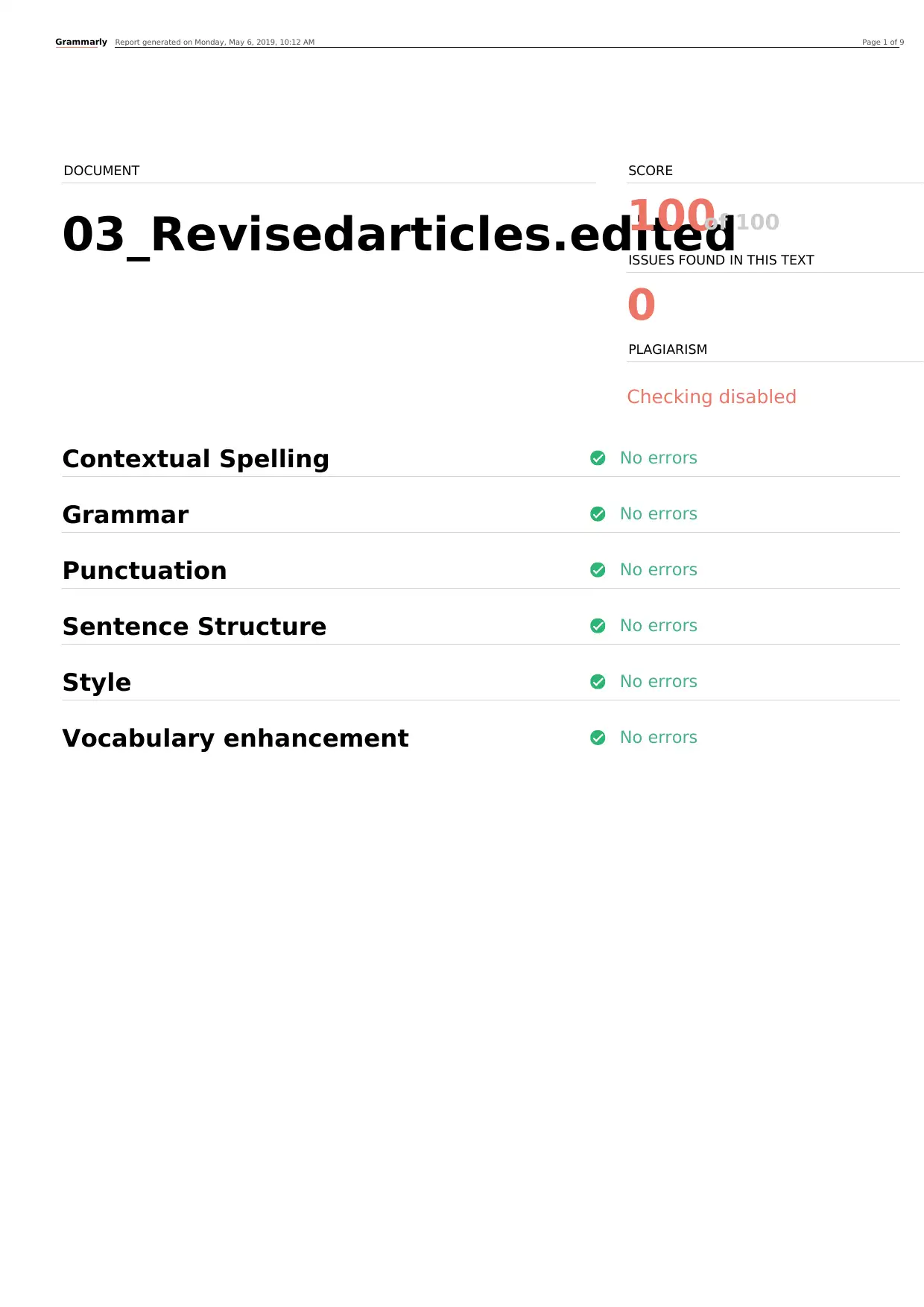
Grammarly Report generated on Monday, May 6, 2019, 10:12 AM Page 1 of 9
DOCUMENT
03_Revisedarticles.edited
SCORE
100
ISSUES FOUND IN THIS TEXT
0
PLAGIARISM
Checking disabled
Contextual Spelling
Grammar
Punctuation
Sentence Structure
Style
Vocabulary enhancement
of 100
No errors
No errors
No errors
No errors
No errors
No errors
DOCUMENT
03_Revisedarticles.edited
SCORE
100
ISSUES FOUND IN THIS TEXT
0
PLAGIARISM
Checking disabled
Contextual Spelling
Grammar
Punctuation
Sentence Structure
Style
Vocabulary enhancement
of 100
No errors
No errors
No errors
No errors
No errors
No errors
Secure Best Marks with AI Grader
Need help grading? Try our AI Grader for instant feedback on your assignments.
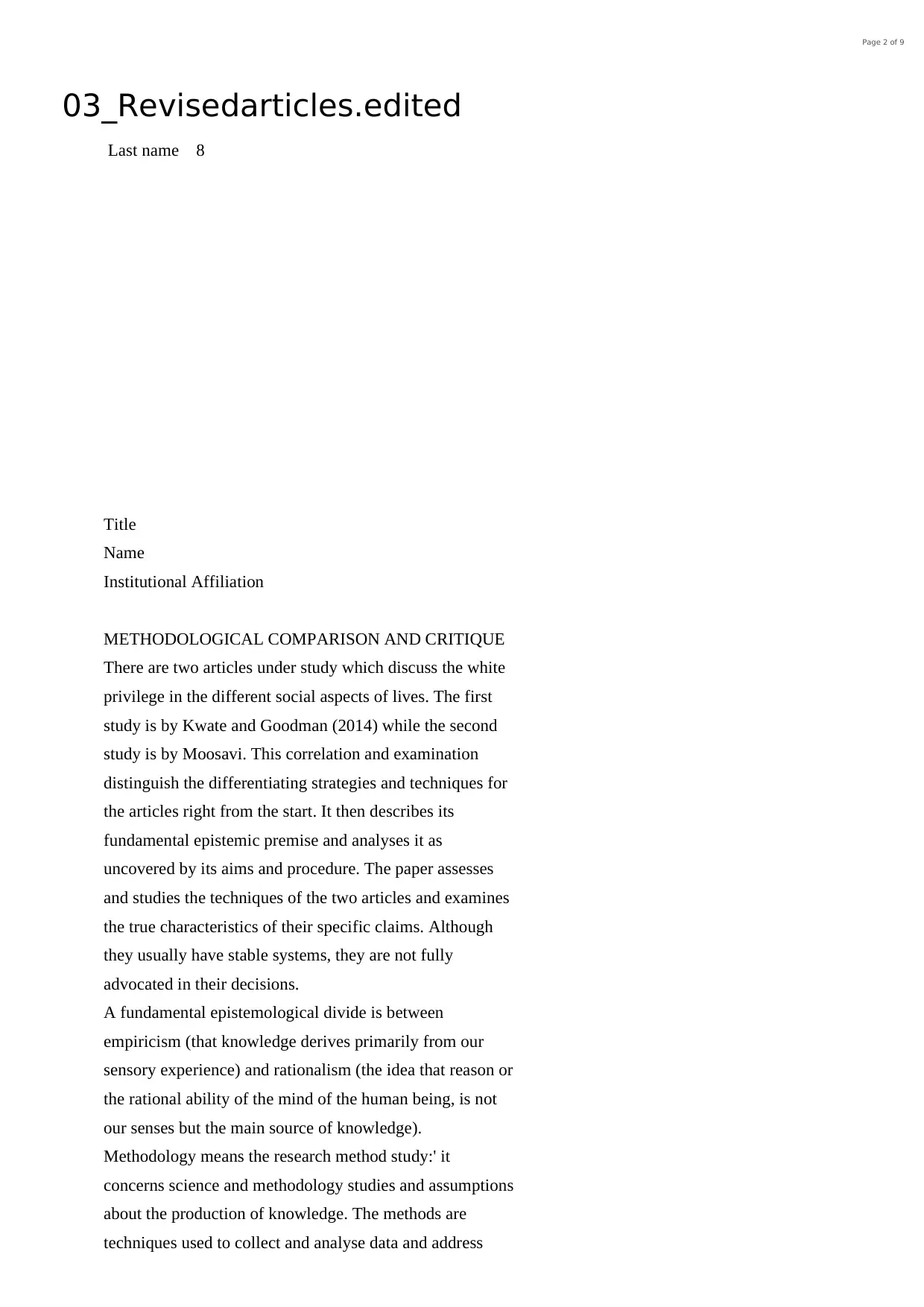
Grammarly Report generated on Monday, May 6, 2019, 10:12 AM Page 2 of 9
03_Revisedarticles.edited
Last name 8
Title
Name
Institutional Affiliation
METHODOLOGICAL COMPARISON AND CRITIQUE
There are two articles under study which discuss the white
privilege in the different social aspects of lives. The first
study is by Kwate and Goodman (2014) while the second
study is by Moosavi. This correlation and examination
distinguish the differentiating strategies and techniques for
the articles right from the start. It then describes its
fundamental epistemic premise and analyses it as
uncovered by its aims and procedure. The paper assesses
and studies the techniques of the two articles and examines
the true characteristics of their specific claims. Although
they usually have stable systems, they are not fully
advocated in their decisions.
A fundamental epistemological divide is between
empiricism (that knowledge derives primarily from our
sensory experience) and rationalism (the idea that reason or
the rational ability of the mind of the human being, is not
our senses but the main source of knowledge).
Methodology means the research method study:' it
concerns science and methodology studies and assumptions
about the production of knowledge. The methods are
techniques used to collect and analyse data and address
03_Revisedarticles.edited
Last name 8
Title
Name
Institutional Affiliation
METHODOLOGICAL COMPARISON AND CRITIQUE
There are two articles under study which discuss the white
privilege in the different social aspects of lives. The first
study is by Kwate and Goodman (2014) while the second
study is by Moosavi. This correlation and examination
distinguish the differentiating strategies and techniques for
the articles right from the start. It then describes its
fundamental epistemic premise and analyses it as
uncovered by its aims and procedure. The paper assesses
and studies the techniques of the two articles and examines
the true characteristics of their specific claims. Although
they usually have stable systems, they are not fully
advocated in their decisions.
A fundamental epistemological divide is between
empiricism (that knowledge derives primarily from our
sensory experience) and rationalism (the idea that reason or
the rational ability of the mind of the human being, is not
our senses but the main source of knowledge).
Methodology means the research method study:' it
concerns science and methodology studies and assumptions
about the production of knowledge. The methods are
techniques used to collect and analyse data and address
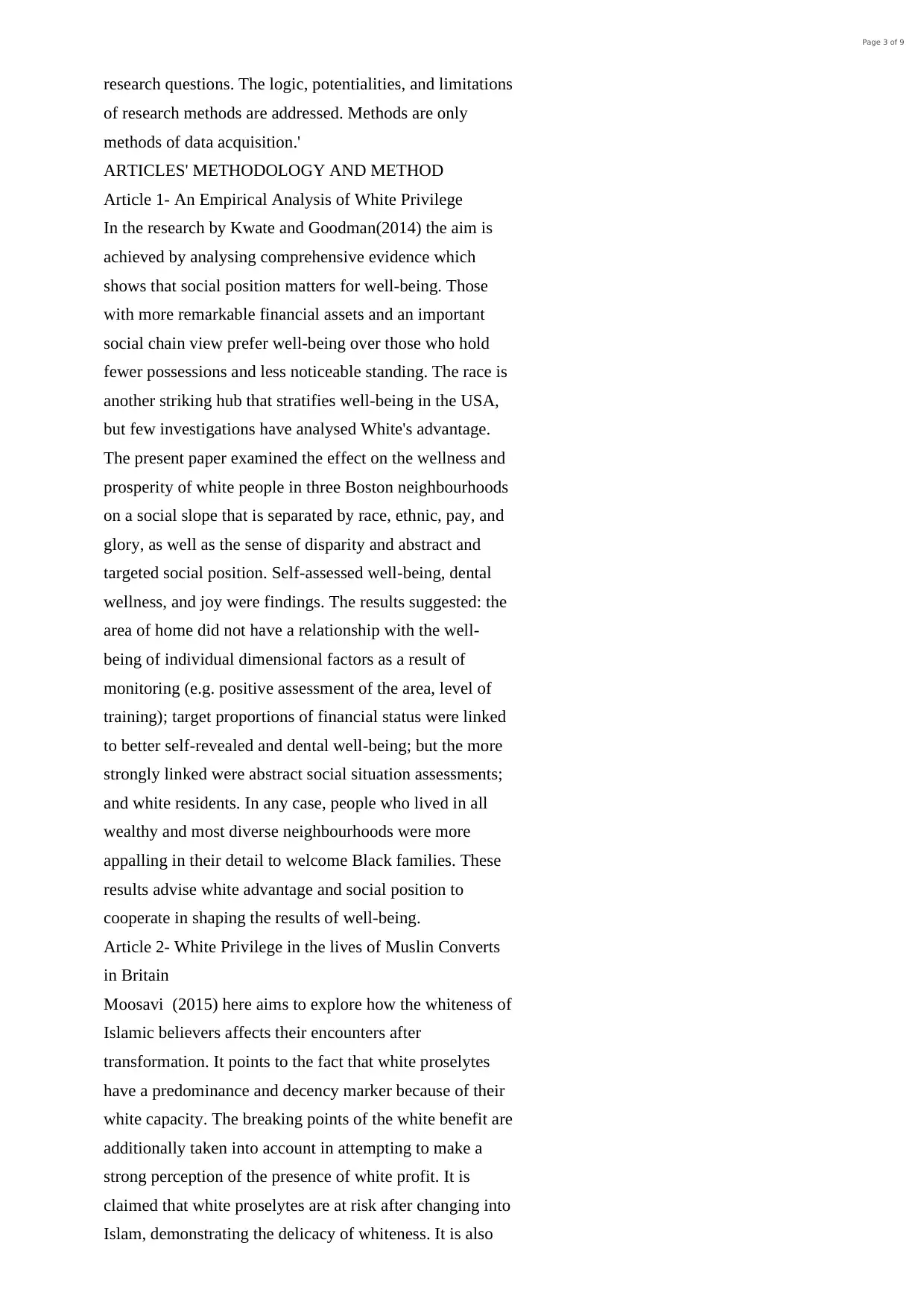
Grammarly Report generated on Monday, May 6, 2019, 10:12 AM Page 3 of 9
research questions. The logic, potentialities, and limitations
of research methods are addressed. Methods are only
methods of data acquisition.'
ARTICLES' METHODOLOGY AND METHOD
Article 1- An Empirical Analysis of White Privilege
In the research by Kwate and Goodman(2014) the aim is
achieved by analysing comprehensive evidence which
shows that social position matters for well-being. Those
with more remarkable financial assets and an important
social chain view prefer well-being over those who hold
fewer possessions and less noticeable standing. The race is
another striking hub that stratifies well-being in the USA,
but few investigations have analysed White's advantage.
The present paper examined the effect on the wellness and
prosperity of white people in three Boston neighbourhoods
on a social slope that is separated by race, ethnic, pay, and
glory, as well as the sense of disparity and abstract and
targeted social position. Self-assessed well-being, dental
wellness, and joy were findings. The results suggested: the
area of home did not have a relationship with the well-
being of individual dimensional factors as a result of
monitoring (e.g. positive assessment of the area, level of
training); target proportions of financial status were linked
to better self-revealed and dental well-being; but the more
strongly linked were abstract social situation assessments;
and white residents. In any case, people who lived in all
wealthy and most diverse neighbourhoods were more
appalling in their detail to welcome Black families. These
results advise white advantage and social position to
cooperate in shaping the results of well-being.
Article 2- White Privilege in the lives of Muslin Converts
in Britain
Moosavi (2015) here aims to explore how the whiteness of
Islamic believers affects their encounters after
transformation. It points to the fact that white proselytes
have a predominance and decency marker because of their
white capacity. The breaking points of the white benefit are
additionally taken into account in attempting to make a
strong perception of the presence of white profit. It is
claimed that white proselytes are at risk after changing into
Islam, demonstrating the delicacy of whiteness. It is also
research questions. The logic, potentialities, and limitations
of research methods are addressed. Methods are only
methods of data acquisition.'
ARTICLES' METHODOLOGY AND METHOD
Article 1- An Empirical Analysis of White Privilege
In the research by Kwate and Goodman(2014) the aim is
achieved by analysing comprehensive evidence which
shows that social position matters for well-being. Those
with more remarkable financial assets and an important
social chain view prefer well-being over those who hold
fewer possessions and less noticeable standing. The race is
another striking hub that stratifies well-being in the USA,
but few investigations have analysed White's advantage.
The present paper examined the effect on the wellness and
prosperity of white people in three Boston neighbourhoods
on a social slope that is separated by race, ethnic, pay, and
glory, as well as the sense of disparity and abstract and
targeted social position. Self-assessed well-being, dental
wellness, and joy were findings. The results suggested: the
area of home did not have a relationship with the well-
being of individual dimensional factors as a result of
monitoring (e.g. positive assessment of the area, level of
training); target proportions of financial status were linked
to better self-revealed and dental well-being; but the more
strongly linked were abstract social situation assessments;
and white residents. In any case, people who lived in all
wealthy and most diverse neighbourhoods were more
appalling in their detail to welcome Black families. These
results advise white advantage and social position to
cooperate in shaping the results of well-being.
Article 2- White Privilege in the lives of Muslin Converts
in Britain
Moosavi (2015) here aims to explore how the whiteness of
Islamic believers affects their encounters after
transformation. It points to the fact that white proselytes
have a predominance and decency marker because of their
white capacity. The breaking points of the white benefit are
additionally taken into account in attempting to make a
strong perception of the presence of white profit. It is
claimed that white proselytes are at risk after changing into
Islam, demonstrating the delicacy of whiteness. It is also
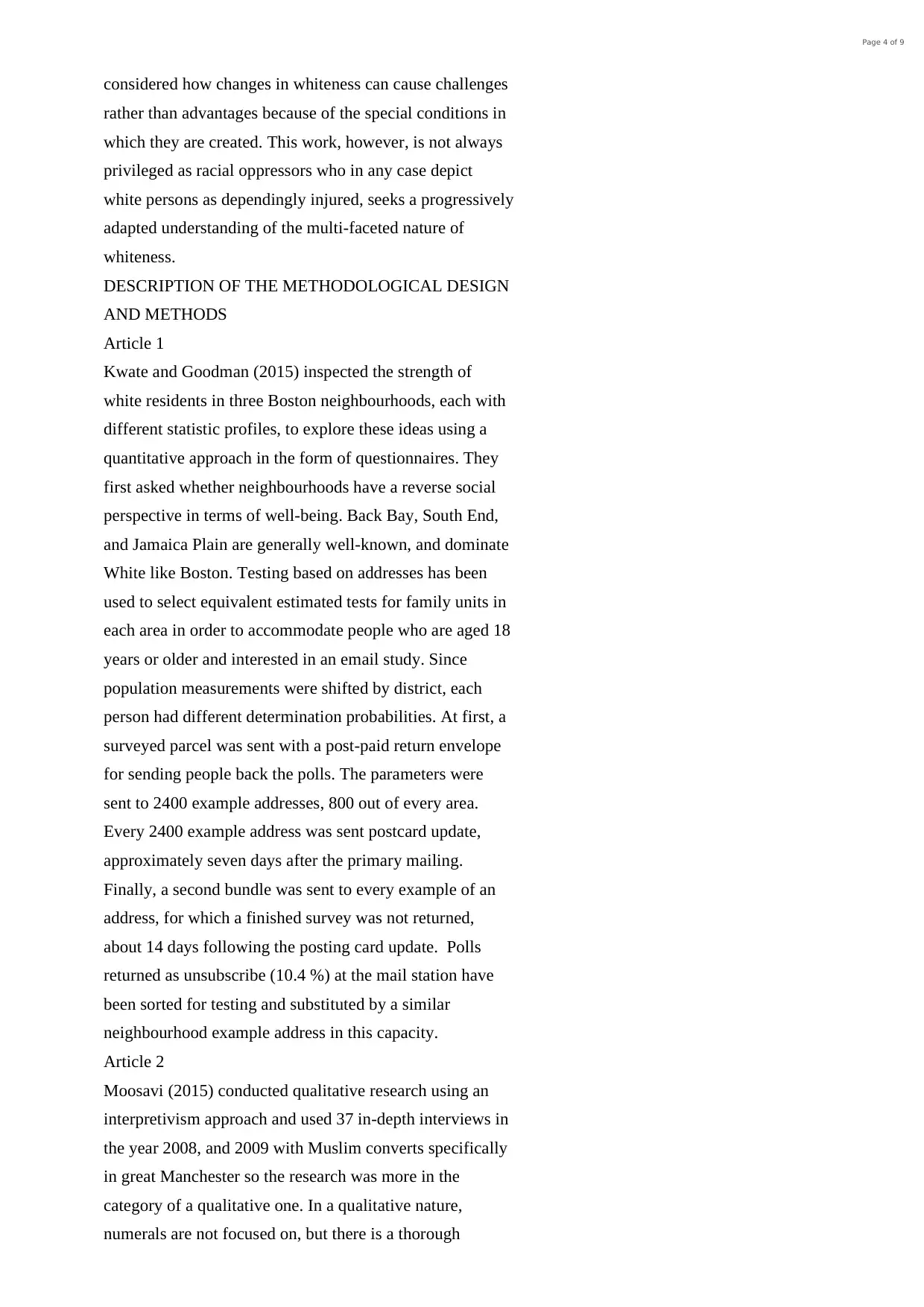
Grammarly Report generated on Monday, May 6, 2019, 10:12 AM Page 4 of 9
considered how changes in whiteness can cause challenges
rather than advantages because of the special conditions in
which they are created. This work, however, is not always
privileged as racial oppressors who in any case depict
white persons as dependingly injured, seeks a progressively
adapted understanding of the multi-faceted nature of
whiteness.
DESCRIPTION OF THE METHODOLOGICAL DESIGN
AND METHODS
Article 1
Kwate and Goodman (2015) inspected the strength of
white residents in three Boston neighbourhoods, each with
different statistic profiles, to explore these ideas using a
quantitative approach in the form of questionnaires. They
first asked whether neighbourhoods have a reverse social
perspective in terms of well-being. Back Bay, South End,
and Jamaica Plain are generally well-known, and dominate
White like Boston. Testing based on addresses has been
used to select equivalent estimated tests for family units in
each area in order to accommodate people who are aged 18
years or older and interested in an email study. Since
population measurements were shifted by district, each
person had different determination probabilities. At first, a
surveyed parcel was sent with a post-paid return envelope
for sending people back the polls. The parameters were
sent to 2400 example addresses, 800 out of every area.
Every 2400 example address was sent postcard update,
approximately seven days after the primary mailing.
Finally, a second bundle was sent to every example of an
address, for which a finished survey was not returned,
about 14 days following the posting card update. Polls
returned as unsubscribe (10.4 %) at the mail station have
been sorted for testing and substituted by a similar
neighbourhood example address in this capacity.
Article 2
Moosavi (2015) conducted qualitative research using an
interpretivism approach and used 37 in-depth interviews in
the year 2008, and 2009 with Muslim converts specifically
in great Manchester so the research was more in the
category of a qualitative one. In a qualitative nature,
numerals are not focused on, but there is a thorough
considered how changes in whiteness can cause challenges
rather than advantages because of the special conditions in
which they are created. This work, however, is not always
privileged as racial oppressors who in any case depict
white persons as dependingly injured, seeks a progressively
adapted understanding of the multi-faceted nature of
whiteness.
DESCRIPTION OF THE METHODOLOGICAL DESIGN
AND METHODS
Article 1
Kwate and Goodman (2015) inspected the strength of
white residents in three Boston neighbourhoods, each with
different statistic profiles, to explore these ideas using a
quantitative approach in the form of questionnaires. They
first asked whether neighbourhoods have a reverse social
perspective in terms of well-being. Back Bay, South End,
and Jamaica Plain are generally well-known, and dominate
White like Boston. Testing based on addresses has been
used to select equivalent estimated tests for family units in
each area in order to accommodate people who are aged 18
years or older and interested in an email study. Since
population measurements were shifted by district, each
person had different determination probabilities. At first, a
surveyed parcel was sent with a post-paid return envelope
for sending people back the polls. The parameters were
sent to 2400 example addresses, 800 out of every area.
Every 2400 example address was sent postcard update,
approximately seven days after the primary mailing.
Finally, a second bundle was sent to every example of an
address, for which a finished survey was not returned,
about 14 days following the posting card update. Polls
returned as unsubscribe (10.4 %) at the mail station have
been sorted for testing and substituted by a similar
neighbourhood example address in this capacity.
Article 2
Moosavi (2015) conducted qualitative research using an
interpretivism approach and used 37 in-depth interviews in
the year 2008, and 2009 with Muslim converts specifically
in great Manchester so the research was more in the
category of a qualitative one. In a qualitative nature,
numerals are not focused on, but there is a thorough
Secure Best Marks with AI Grader
Need help grading? Try our AI Grader for instant feedback on your assignments.
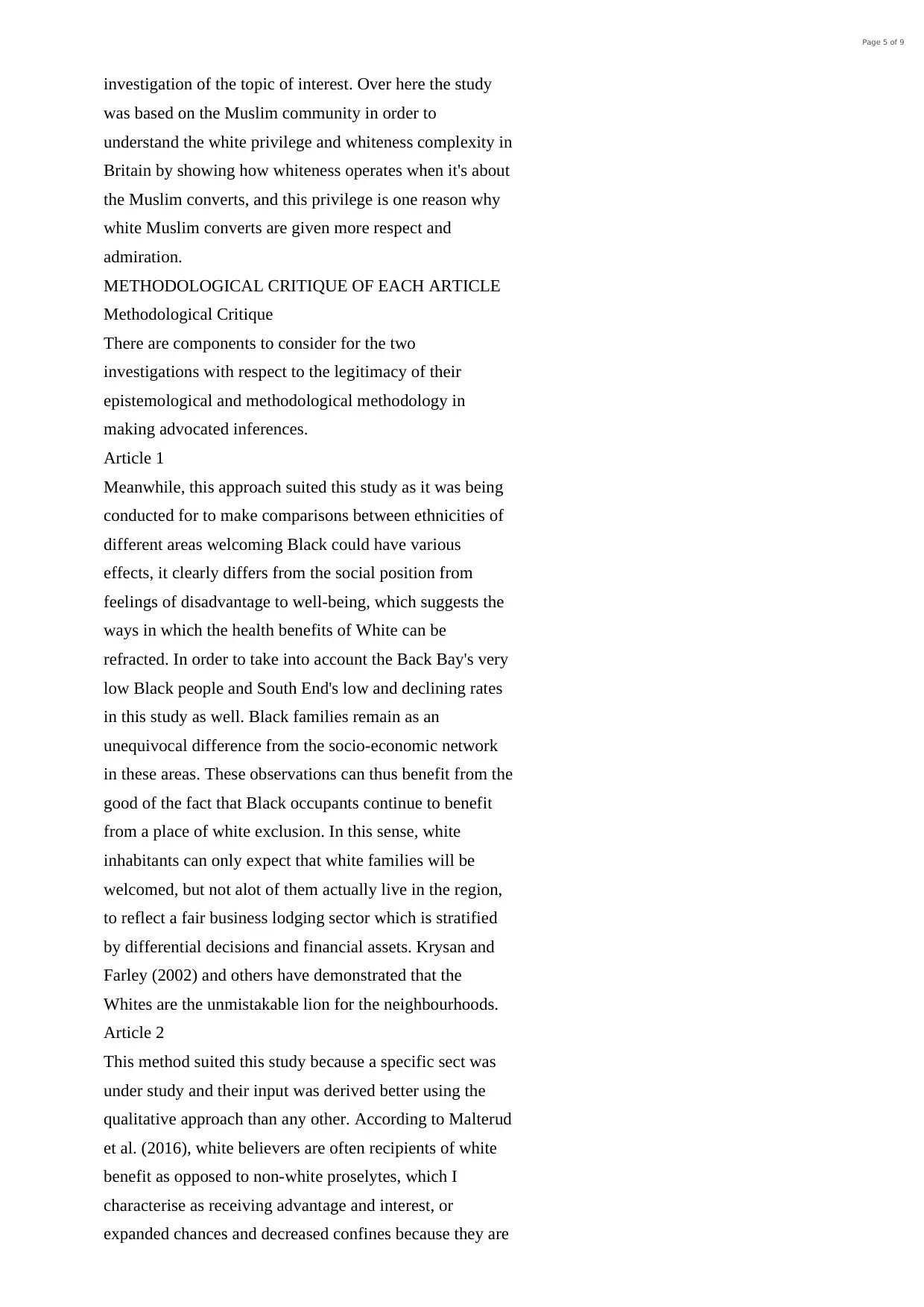
Grammarly Report generated on Monday, May 6, 2019, 10:12 AM Page 5 of 9
investigation of the topic of interest. Over here the study
was based on the Muslim community in order to
understand the white privilege and whiteness complexity in
Britain by showing how whiteness operates when it's about
the Muslim converts, and this privilege is one reason why
white Muslim converts are given more respect and
admiration.
METHODOLOGICAL CRITIQUE OF EACH ARTICLE
Methodological Critique
There are components to consider for the two
investigations with respect to the legitimacy of their
epistemological and methodological methodology in
making advocated inferences.
Article 1
Meanwhile, this approach suited this study as it was being
conducted for to make comparisons between ethnicities of
different areas welcoming Black could have various
effects, it clearly differs from the social position from
feelings of disadvantage to well-being, which suggests the
ways in which the health benefits of White can be
refracted. In order to take into account the Back Bay's very
low Black people and South End's low and declining rates
in this study as well. Black families remain as an
unequivocal difference from the socio-economic network
in these areas. These observations can thus benefit from the
good of the fact that Black occupants continue to benefit
from a place of white exclusion. In this sense, white
inhabitants can only expect that white families will be
welcomed, but not alot of them actually live in the region,
to reflect a fair business lodging sector which is stratified
by differential decisions and financial assets. Krysan and
Farley (2002) and others have demonstrated that the
Whites are the unmistakable lion for the neighbourhoods.
Article 2
This method suited this study because a specific sect was
under study and their input was derived better using the
qualitative approach than any other. According to Malterud
et al. (2016), white believers are often recipients of white
benefit as opposed to non-white proselytes, which I
characterise as receiving advantage and interest, or
expanded chances and decreased confines because they are
investigation of the topic of interest. Over here the study
was based on the Muslim community in order to
understand the white privilege and whiteness complexity in
Britain by showing how whiteness operates when it's about
the Muslim converts, and this privilege is one reason why
white Muslim converts are given more respect and
admiration.
METHODOLOGICAL CRITIQUE OF EACH ARTICLE
Methodological Critique
There are components to consider for the two
investigations with respect to the legitimacy of their
epistemological and methodological methodology in
making advocated inferences.
Article 1
Meanwhile, this approach suited this study as it was being
conducted for to make comparisons between ethnicities of
different areas welcoming Black could have various
effects, it clearly differs from the social position from
feelings of disadvantage to well-being, which suggests the
ways in which the health benefits of White can be
refracted. In order to take into account the Back Bay's very
low Black people and South End's low and declining rates
in this study as well. Black families remain as an
unequivocal difference from the socio-economic network
in these areas. These observations can thus benefit from the
good of the fact that Black occupants continue to benefit
from a place of white exclusion. In this sense, white
inhabitants can only expect that white families will be
welcomed, but not alot of them actually live in the region,
to reflect a fair business lodging sector which is stratified
by differential decisions and financial assets. Krysan and
Farley (2002) and others have demonstrated that the
Whites are the unmistakable lion for the neighbourhoods.
Article 2
This method suited this study because a specific sect was
under study and their input was derived better using the
qualitative approach than any other. According to Malterud
et al. (2016), white believers are often recipients of white
benefit as opposed to non-white proselytes, which I
characterise as receiving advantage and interest, or
expanded chances and decreased confines because they are
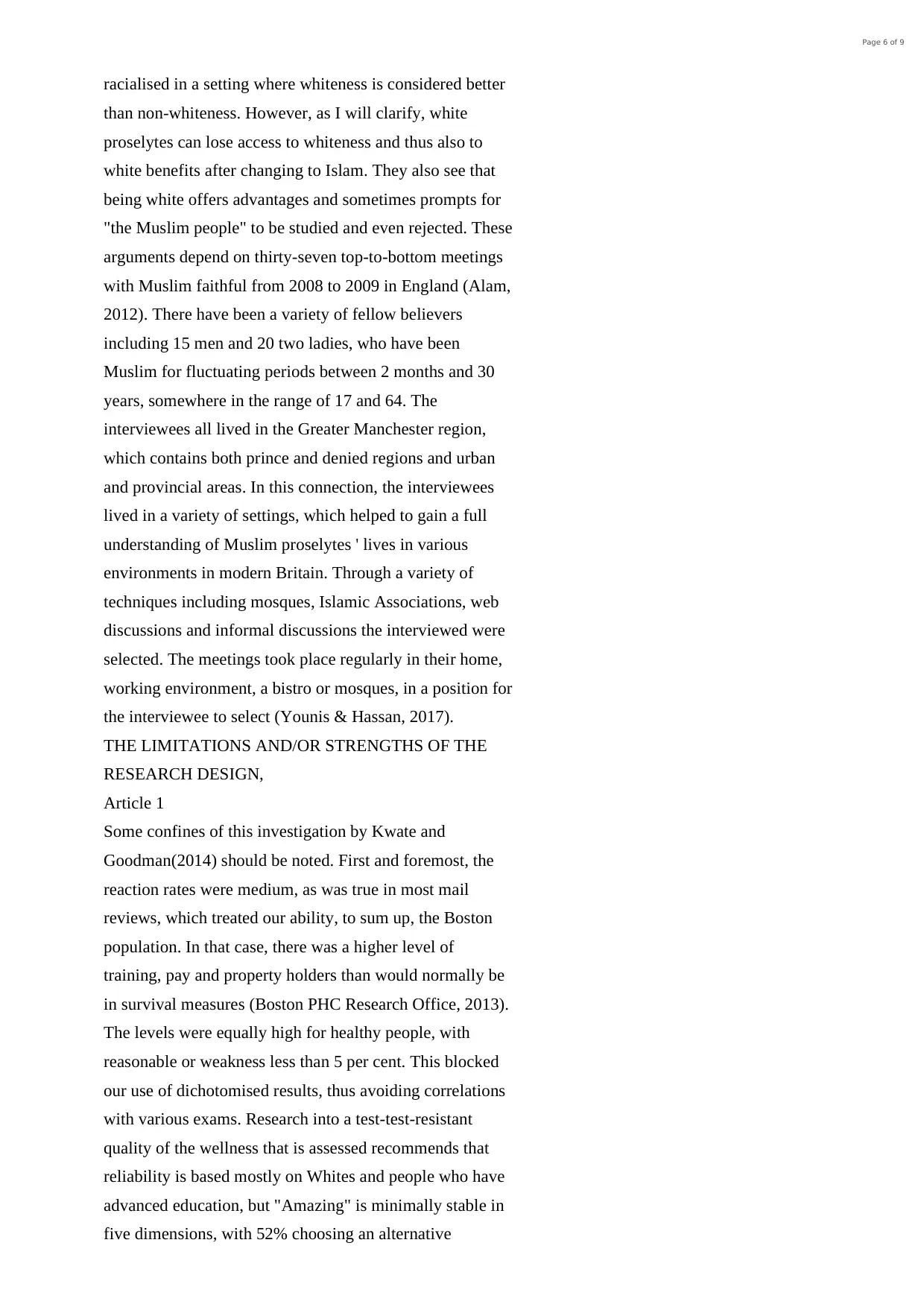
Grammarly Report generated on Monday, May 6, 2019, 10:12 AM Page 6 of 9
racialised in a setting where whiteness is considered better
than non-whiteness. However, as I will clarify, white
proselytes can lose access to whiteness and thus also to
white benefits after changing to Islam. They also see that
being white offers advantages and sometimes prompts for
"the Muslim people" to be studied and even rejected. These
arguments depend on thirty-seven top-to-bottom meetings
with Muslim faithful from 2008 to 2009 in England (Alam,
2012). There have been a variety of fellow believers
including 15 men and 20 two ladies, who have been
Muslim for fluctuating periods between 2 months and 30
years, somewhere in the range of 17 and 64. The
interviewees all lived in the Greater Manchester region,
which contains both prince and denied regions and urban
and provincial areas. In this connection, the interviewees
lived in a variety of settings, which helped to gain a full
understanding of Muslim proselytes ' lives in various
environments in modern Britain. Through a variety of
techniques including mosques, Islamic Associations, web
discussions and informal discussions the interviewed were
selected. The meetings took place regularly in their home,
working environment, a bistro or mosques, in a position for
the interviewee to select (Younis & Hassan, 2017).
THE LIMITATIONS AND/OR STRENGTHS OF THE
RESEARCH DESIGN,
Article 1
Some confines of this investigation by Kwate and
Goodman(2014) should be noted. First and foremost, the
reaction rates were medium, as was true in most mail
reviews, which treated our ability, to sum up, the Boston
population. In that case, there was a higher level of
training, pay and property holders than would normally be
in survival measures (Boston PHC Research Office, 2013).
The levels were equally high for healthy people, with
reasonable or weakness less than 5 per cent. This blocked
our use of dichotomised results, thus avoiding correlations
with various exams. Research into a test-test-resistant
quality of the wellness that is assessed recommends that
reliability is based mostly on Whites and people who have
advanced education, but "Amazing" is minimally stable in
five dimensions, with 52% choosing an alternative
racialised in a setting where whiteness is considered better
than non-whiteness. However, as I will clarify, white
proselytes can lose access to whiteness and thus also to
white benefits after changing to Islam. They also see that
being white offers advantages and sometimes prompts for
"the Muslim people" to be studied and even rejected. These
arguments depend on thirty-seven top-to-bottom meetings
with Muslim faithful from 2008 to 2009 in England (Alam,
2012). There have been a variety of fellow believers
including 15 men and 20 two ladies, who have been
Muslim for fluctuating periods between 2 months and 30
years, somewhere in the range of 17 and 64. The
interviewees all lived in the Greater Manchester region,
which contains both prince and denied regions and urban
and provincial areas. In this connection, the interviewees
lived in a variety of settings, which helped to gain a full
understanding of Muslim proselytes ' lives in various
environments in modern Britain. Through a variety of
techniques including mosques, Islamic Associations, web
discussions and informal discussions the interviewed were
selected. The meetings took place regularly in their home,
working environment, a bistro or mosques, in a position for
the interviewee to select (Younis & Hassan, 2017).
THE LIMITATIONS AND/OR STRENGTHS OF THE
RESEARCH DESIGN,
Article 1
Some confines of this investigation by Kwate and
Goodman(2014) should be noted. First and foremost, the
reaction rates were medium, as was true in most mail
reviews, which treated our ability, to sum up, the Boston
population. In that case, there was a higher level of
training, pay and property holders than would normally be
in survival measures (Boston PHC Research Office, 2013).
The levels were equally high for healthy people, with
reasonable or weakness less than 5 per cent. This blocked
our use of dichotomised results, thus avoiding correlations
with various exams. Research into a test-test-resistant
quality of the wellness that is assessed recommends that
reliability is based mostly on Whites and people who have
advanced education, but "Amazing" is minimally stable in
five dimensions, with 52% choosing an alternative
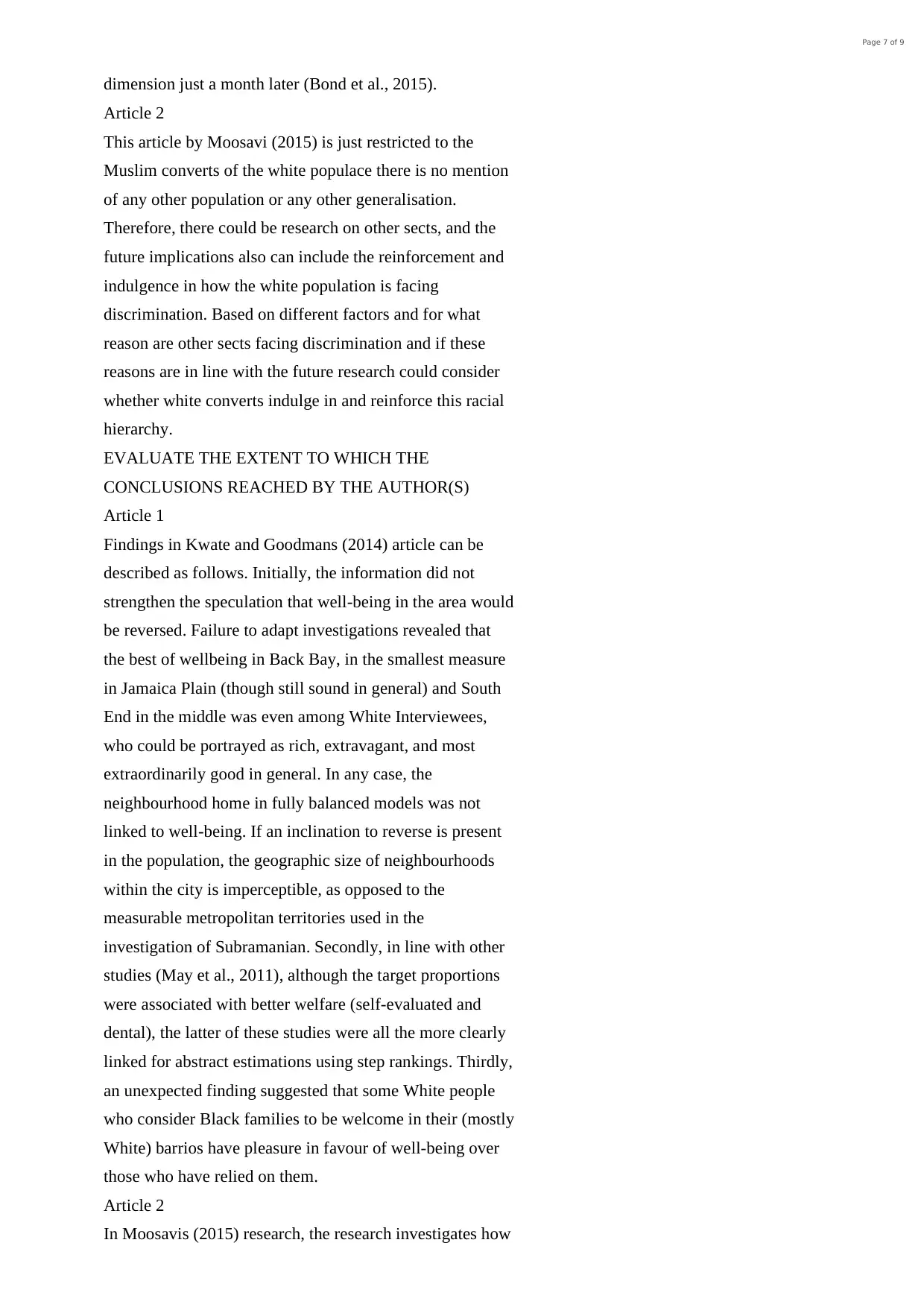
Grammarly Report generated on Monday, May 6, 2019, 10:12 AM Page 7 of 9
dimension just a month later (Bond et al., 2015).
Article 2
This article by Moosavi (2015) is just restricted to the
Muslim converts of the white populace there is no mention
of any other population or any other generalisation.
Therefore, there could be research on other sects, and the
future implications also can include the reinforcement and
indulgence in how the white population is facing
discrimination. Based on different factors and for what
reason are other sects facing discrimination and if these
reasons are in line with the future research could consider
whether white converts indulge in and reinforce this racial
hierarchy.
EVALUATE THE EXTENT TO WHICH THE
CONCLUSIONS REACHED BY THE AUTHOR(S)
Article 1
Findings in Kwate and Goodmans (2014) article can be
described as follows. Initially, the information did not
strengthen the speculation that well-being in the area would
be reversed. Failure to adapt investigations revealed that
the best of wellbeing in Back Bay, in the smallest measure
in Jamaica Plain (though still sound in general) and South
End in the middle was even among White Interviewees,
who could be portrayed as rich, extravagant, and most
extraordinarily good in general. In any case, the
neighbourhood home in fully balanced models was not
linked to well-being. If an inclination to reverse is present
in the population, the geographic size of neighbourhoods
within the city is imperceptible, as opposed to the
measurable metropolitan territories used in the
investigation of Subramanian. Secondly, in line with other
studies (May et al., 2011), although the target proportions
were associated with better welfare (self-evaluated and
dental), the latter of these studies were all the more clearly
linked for abstract estimations using step rankings. Thirdly,
an unexpected finding suggested that some White people
who consider Black families to be welcome in their (mostly
White) barrios have pleasure in favour of well-being over
those who have relied on them.
Article 2
In Moosavis (2015) research, the research investigates how
dimension just a month later (Bond et al., 2015).
Article 2
This article by Moosavi (2015) is just restricted to the
Muslim converts of the white populace there is no mention
of any other population or any other generalisation.
Therefore, there could be research on other sects, and the
future implications also can include the reinforcement and
indulgence in how the white population is facing
discrimination. Based on different factors and for what
reason are other sects facing discrimination and if these
reasons are in line with the future research could consider
whether white converts indulge in and reinforce this racial
hierarchy.
EVALUATE THE EXTENT TO WHICH THE
CONCLUSIONS REACHED BY THE AUTHOR(S)
Article 1
Findings in Kwate and Goodmans (2014) article can be
described as follows. Initially, the information did not
strengthen the speculation that well-being in the area would
be reversed. Failure to adapt investigations revealed that
the best of wellbeing in Back Bay, in the smallest measure
in Jamaica Plain (though still sound in general) and South
End in the middle was even among White Interviewees,
who could be portrayed as rich, extravagant, and most
extraordinarily good in general. In any case, the
neighbourhood home in fully balanced models was not
linked to well-being. If an inclination to reverse is present
in the population, the geographic size of neighbourhoods
within the city is imperceptible, as opposed to the
measurable metropolitan territories used in the
investigation of Subramanian. Secondly, in line with other
studies (May et al., 2011), although the target proportions
were associated with better welfare (self-evaluated and
dental), the latter of these studies were all the more clearly
linked for abstract estimations using step rankings. Thirdly,
an unexpected finding suggested that some White people
who consider Black families to be welcome in their (mostly
White) barrios have pleasure in favour of well-being over
those who have relied on them.
Article 2
In Moosavis (2015) research, the research investigates how
Paraphrase This Document
Need a fresh take? Get an instant paraphrase of this document with our AI Paraphraser
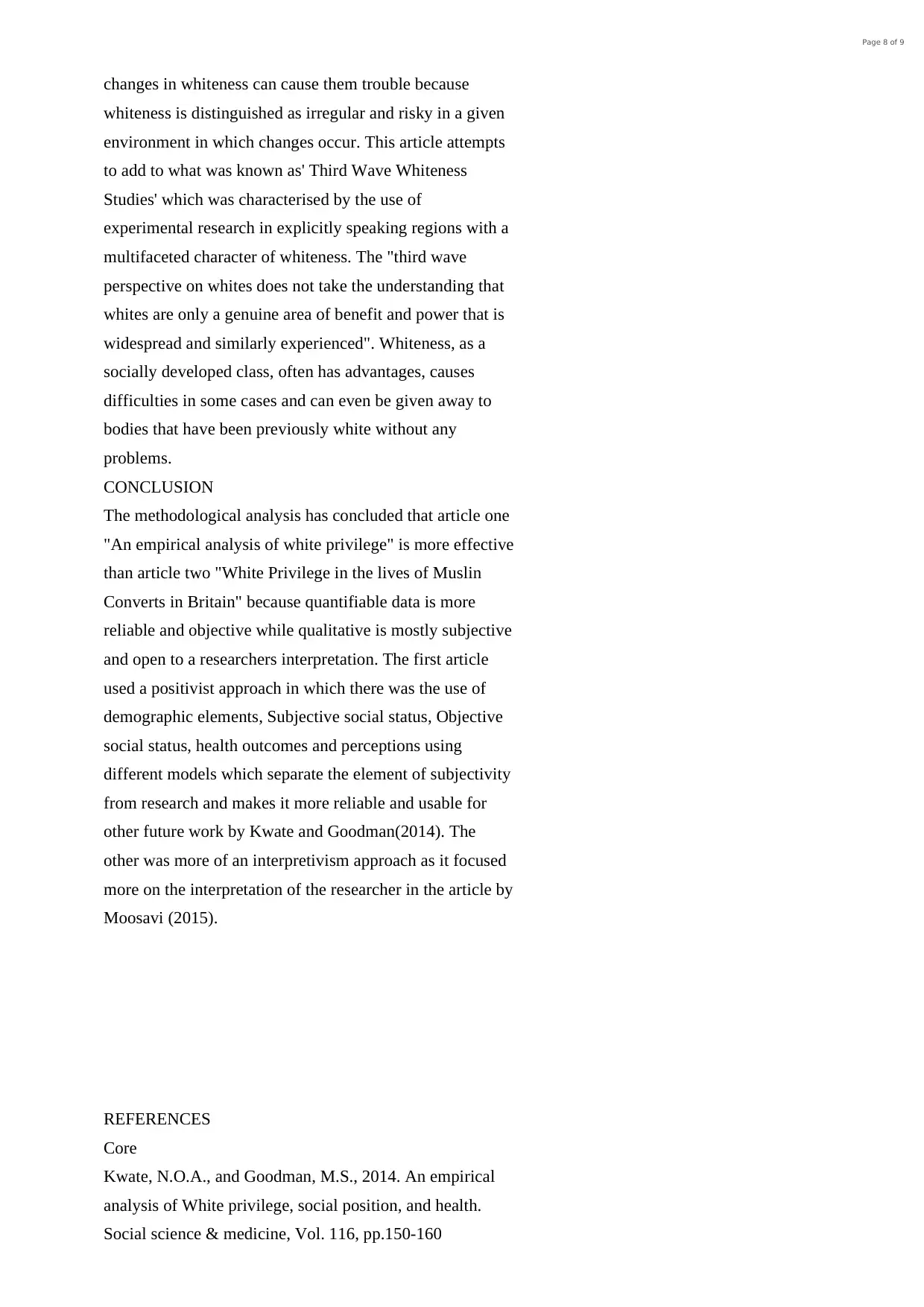
Grammarly Report generated on Monday, May 6, 2019, 10:12 AM Page 8 of 9
changes in whiteness can cause them trouble because
whiteness is distinguished as irregular and risky in a given
environment in which changes occur. This article attempts
to add to what was known as' Third Wave Whiteness
Studies' which was characterised by the use of
experimental research in explicitly speaking regions with a
multifaceted character of whiteness. The "third wave
perspective on whites does not take the understanding that
whites are only a genuine area of benefit and power that is
widespread and similarly experienced". Whiteness, as a
socially developed class, often has advantages, causes
difficulties in some cases and can even be given away to
bodies that have been previously white without any
problems.
CONCLUSION
The methodological analysis has concluded that article one
"An empirical analysis of white privilege" is more effective
than article two "White Privilege in the lives of Muslin
Converts in Britain" because quantifiable data is more
reliable and objective while qualitative is mostly subjective
and open to a researchers interpretation. The first article
used a positivist approach in which there was the use of
demographic elements, Subjective social status, Objective
social status, health outcomes and perceptions using
different models which separate the element of subjectivity
from research and makes it more reliable and usable for
other future work by Kwate and Goodman(2014). The
other was more of an interpretivism approach as it focused
more on the interpretation of the researcher in the article by
Moosavi (2015).
REFERENCES
Core
Kwate, N.O.A., and Goodman, M.S., 2014. An empirical
analysis of White privilege, social position, and health.
Social science & medicine, Vol. 116, pp.150-160
changes in whiteness can cause them trouble because
whiteness is distinguished as irregular and risky in a given
environment in which changes occur. This article attempts
to add to what was known as' Third Wave Whiteness
Studies' which was characterised by the use of
experimental research in explicitly speaking regions with a
multifaceted character of whiteness. The "third wave
perspective on whites does not take the understanding that
whites are only a genuine area of benefit and power that is
widespread and similarly experienced". Whiteness, as a
socially developed class, often has advantages, causes
difficulties in some cases and can even be given away to
bodies that have been previously white without any
problems.
CONCLUSION
The methodological analysis has concluded that article one
"An empirical analysis of white privilege" is more effective
than article two "White Privilege in the lives of Muslin
Converts in Britain" because quantifiable data is more
reliable and objective while qualitative is mostly subjective
and open to a researchers interpretation. The first article
used a positivist approach in which there was the use of
demographic elements, Subjective social status, Objective
social status, health outcomes and perceptions using
different models which separate the element of subjectivity
from research and makes it more reliable and usable for
other future work by Kwate and Goodman(2014). The
other was more of an interpretivism approach as it focused
more on the interpretation of the researcher in the article by
Moosavi (2015).
REFERENCES
Core
Kwate, N.O.A., and Goodman, M.S., 2014. An empirical
analysis of White privilege, social position, and health.
Social science & medicine, Vol. 116, pp.150-160
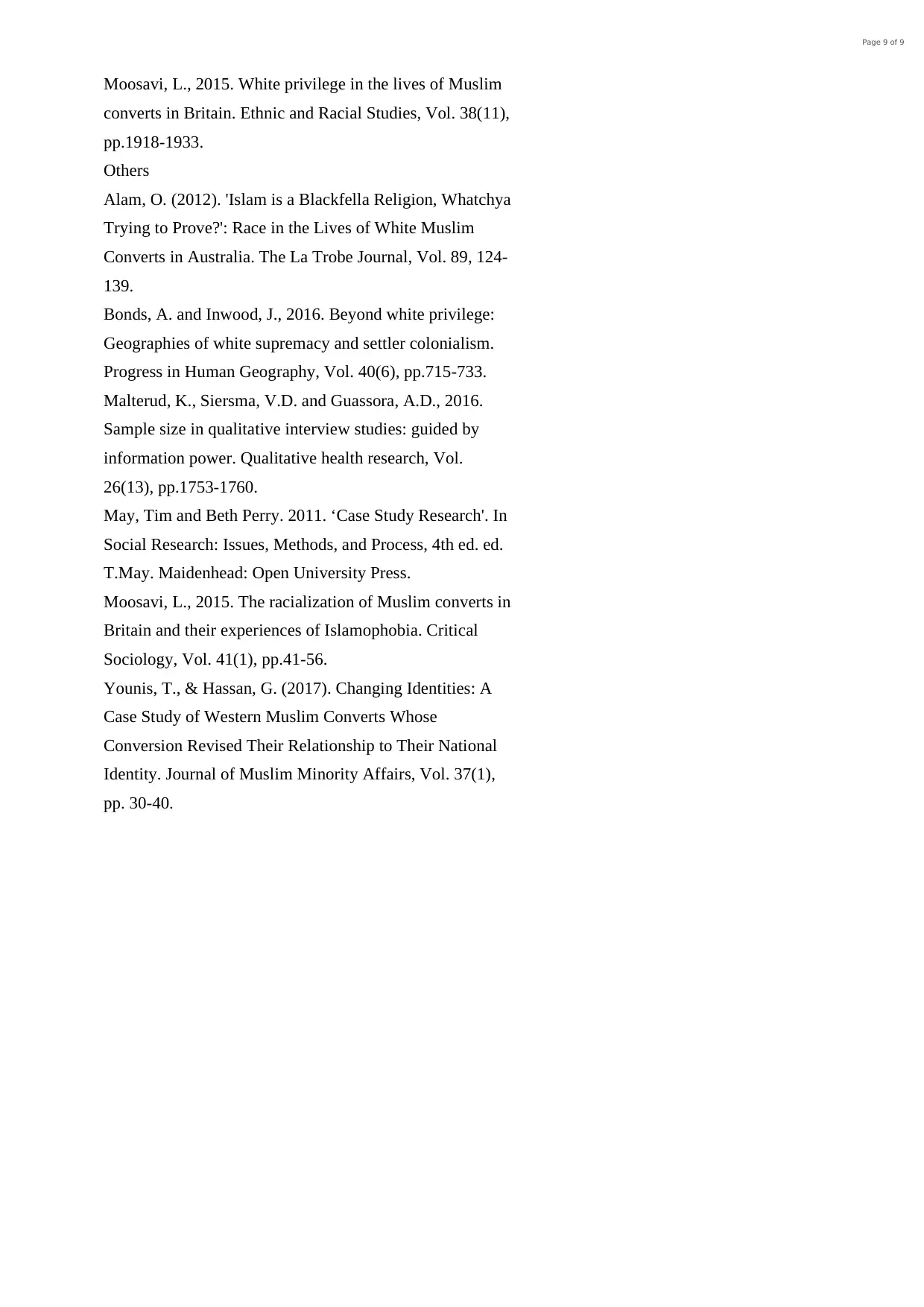
Grammarly Report generated on Monday, May 6, 2019, 10:12 AM Page 9 of 9
Moosavi, L., 2015. White privilege in the lives of Muslim
converts in Britain. Ethnic and Racial Studies, Vol. 38(11),
pp.1918-1933.
Others
Alam, O. (2012). 'Islam is a Blackfella Religion, Whatchya
Trying to Prove?': Race in the Lives of White Muslim
Converts in Australia. The La Trobe Journal, Vol. 89, 124-
139.
Bonds, A. and Inwood, J., 2016. Beyond white privilege:
Geographies of white supremacy and settler colonialism.
Progress in Human Geography, Vol. 40(6), pp.715-733.
Malterud, K., Siersma, V.D. and Guassora, A.D., 2016.
Sample size in qualitative interview studies: guided by
information power. Qualitative health research, Vol.
26(13), pp.1753-1760.
May, Tim and Beth Perry. 2011. ‘Case Study Research'. In
Social Research: Issues, Methods, and Process, 4th ed. ed.
T.May. Maidenhead: Open University Press.
Moosavi, L., 2015. The racialization of Muslim converts in
Britain and their experiences of Islamophobia. Critical
Sociology, Vol. 41(1), pp.41-56.
Younis, T., & Hassan, G. (2017). Changing Identities: A
Case Study of Western Muslim Converts Whose
Conversion Revised Their Relationship to Their National
Identity. Journal of Muslim Minority Affairs, Vol. 37(1),
pp. 30-40.
Moosavi, L., 2015. White privilege in the lives of Muslim
converts in Britain. Ethnic and Racial Studies, Vol. 38(11),
pp.1918-1933.
Others
Alam, O. (2012). 'Islam is a Blackfella Religion, Whatchya
Trying to Prove?': Race in the Lives of White Muslim
Converts in Australia. The La Trobe Journal, Vol. 89, 124-
139.
Bonds, A. and Inwood, J., 2016. Beyond white privilege:
Geographies of white supremacy and settler colonialism.
Progress in Human Geography, Vol. 40(6), pp.715-733.
Malterud, K., Siersma, V.D. and Guassora, A.D., 2016.
Sample size in qualitative interview studies: guided by
information power. Qualitative health research, Vol.
26(13), pp.1753-1760.
May, Tim and Beth Perry. 2011. ‘Case Study Research'. In
Social Research: Issues, Methods, and Process, 4th ed. ed.
T.May. Maidenhead: Open University Press.
Moosavi, L., 2015. The racialization of Muslim converts in
Britain and their experiences of Islamophobia. Critical
Sociology, Vol. 41(1), pp.41-56.
Younis, T., & Hassan, G. (2017). Changing Identities: A
Case Study of Western Muslim Converts Whose
Conversion Revised Their Relationship to Their National
Identity. Journal of Muslim Minority Affairs, Vol. 37(1),
pp. 30-40.
1 out of 9
Related Documents
Your All-in-One AI-Powered Toolkit for Academic Success.
+13062052269
info@desklib.com
Available 24*7 on WhatsApp / Email
![[object Object]](/_next/static/media/star-bottom.7253800d.svg)
Unlock your academic potential
© 2024 | Zucol Services PVT LTD | All rights reserved.





